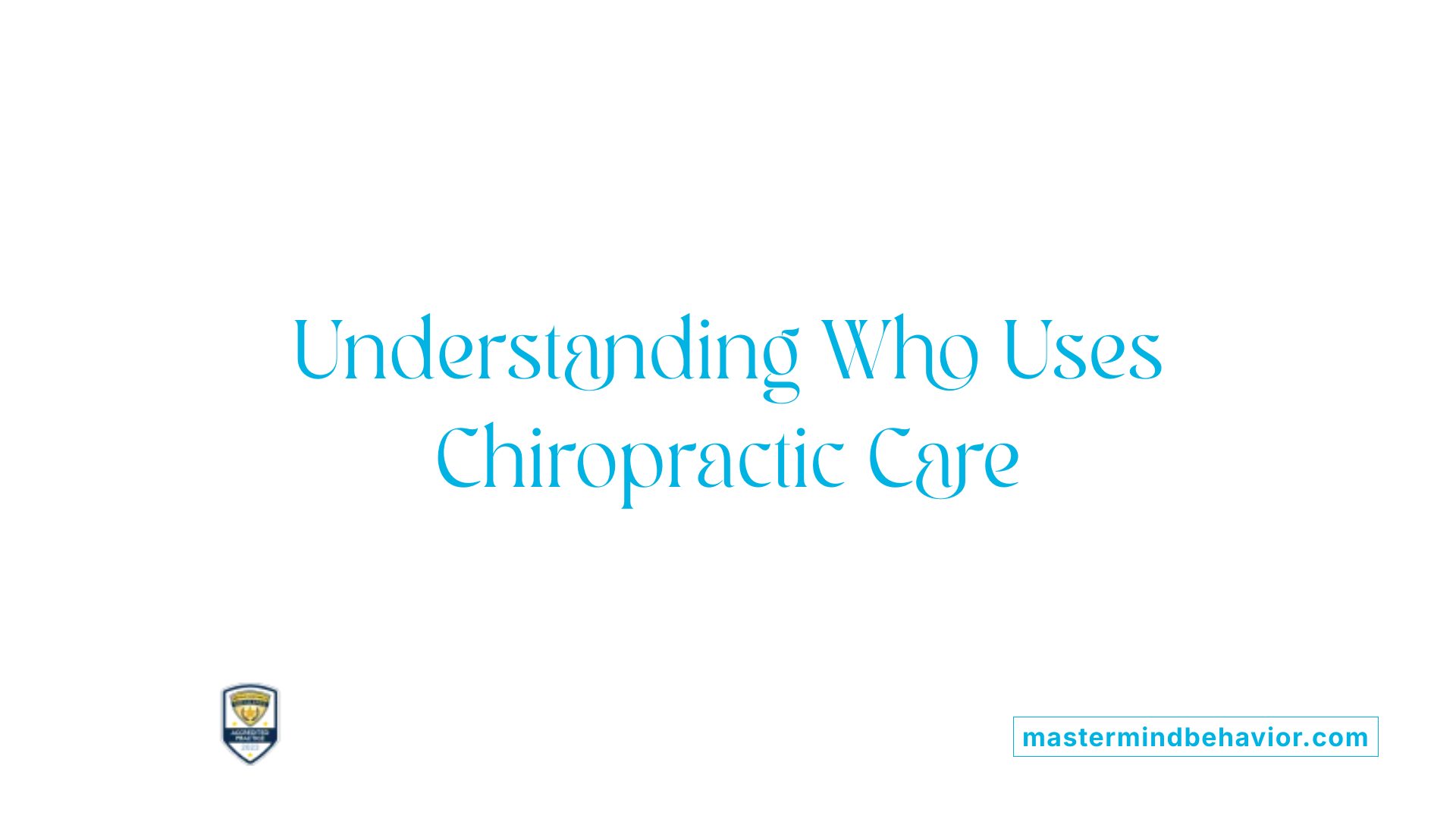Chiropractic Statistics

Understanding the Chiropractic Domain
Chiropractic care plays a significant role in modern healthcare, particularly as an alternative treatment for musculoskeletal issues like back and neck pain. With an increasing number of individuals seeking non-invasive and drug-free therapeutic options, chiropractic services are gaining attention and acceptance across various demographics in the United States. This article delves into the statistics surrounding the chiropractic profession, aiming to provide a comprehensive understanding of its impact, effectiveness, and integration into the broader healthcare landscape.
Chiropractic Workforce and Professional Growth

How many chiropractors are there in the US?
As of May 2023, there are approximately 61,200 licensed chiropractors actively working in the United States. Importantly, the total number of registered chiropractors exceeds 70,000, showcasing the broad scope of this profession. On average, about 3,000 chiropractors are engaged in academic and management roles, further contributing to the field.
Chiropractic employment figures
The chiropractic profession is supported by a significant number of professionals. Each year, approximately 2,500 chiropractic graduates enter the workforce from the 18 accredited doctoral programs across the country. Additionally, there are 40,000 chiropractic assistants employed in various clinical and business management roles.
Job growth projections
Looking to the future, the chiropractic field is expected to grow robustly. Projections indicate a 10% increase in job opportunities for chiropractors from 2023 to 2033. With about 3,100 openings anticipated annually due to workforce turnover, there is a positive outlook for those entering the chiropractic profession.
Utilization and Demographic Trends in Chiropractic Care

What percentage of people use a chiropractor?
Approximately 50% of U.S. adults have visited a chiropractor at some point in their lives, with 14% doing so within the last 12 months. An additional 12% have sought chiropractic services in the past five years, and 25% have visited more than five years ago. The perception of chiropractic care is largely positive; about 81% of adults believe that it can effectively assist with neck and back pain. Moreover, many patients express high levels of satisfaction with their experiences. Notably, 77% of individuals who saw a chiropractor rated their treatment as 'very effective.'
Demographics of chiropractic patients
The demographic landscape reveals interesting trends regarding who utilizes chiropractic services. Usage is notably higher among women, who account for 60% of chiropractic patients. Among specific age groups, adults aged 45-64 represent the highest percentage of users at 11.4%, indicating that this demographic particularly benefits from chiropractic care. Furthermore, a significant portion of chiropractic patients—approximately 46%—visit for treatment of lower back pain, illustrating the prevalent health issues addressed by chiropractic practices.
Chiropractic Treatment Effectiveness and Patient Satisfaction

What is the success rate of chiropractic treatment?
Chiropractic care has demonstrated effectiveness in treating chronic pain conditions, particularly low-back pain (CLBP) and neck pain (CNP). Studies show that about 73.2% of patients with CLBP report very to extremely successful outcomes, with 64.7% noting significant improvement. Similarly, for those suffering from CNP, the rates are 72.2% and 62.5% for overall success and improvement, respectively.
The study, which followed 1,362 patients over three months, also highlighted that patients who attended chiropractic sessions more than once a week achieved better results in terms of pain relief and mobility. This indicates that while the improvements from chiropractic care are notable, consistency in treatment frequency plays a vital role in enhancing the results.
What do patients think about chiropractic care?
Patient satisfaction with chiropractic services is remarkably high. Recent survey results indicated that 77% of individuals who utilized chiropractic care found it to be 'very effective'. Furthermore, 83% reported satisfaction with their treatment experience, underscoring the positive perception of chiropractic interventions within healthcare settings.
Chiropractic care is often preferred over other treatment modalities for back pain, with patients feeling they receive personalized attention and valuable information about managing their pain. This focus on patient-centered care contributes significantly to the overall positive outcomes and satisfaction rates among chiropractic patients.
Economic Impact of Chiropractic Care

Cost-effectiveness of chiropractic treatments
Chiropractic care has established itself as a cost-effective solution for managing musculoskeletal issues. Treatment for low-back pain by a chiropractor can cost 40% less than seeing a medical doctor. This significant difference highlights the economic advantages for patients. Regular chiropractic visits can lower pharmaceutical expenses by 85%, and an estimated 83.5 million dollars could be saved by Medicare annually if chiropractic treatments replaced some conventional doctor visits for back pain.
In 2022, chiropractic care was ranked as a vital alternative healthcare service, with the U.S. chiropractic market valued at approximately $20 billion, further indicating its financial significance within health services.
Economic benefits for healthcare systems
The economic implications of chiropractic care extend beyond individual savings. A systematic review revealed that healthcare costs for spine pain management are generally lower when managed through chiropractic care compared to alternative interventions. With projections estimating annual savings of up to $83.5 million for Medicare, the financial benefits of integrating chiropractic services into broader healthcare systems are markedly evident.
Furthermore, the chiropractic industry plays a vital role in the economy by providing employment opportunities and further promoting healthier, cost-effective pain management solutions for millions of Americans. As over 35 million people seek chiropractic care yearly, the reliance on this form of treatment underscores its essential contribution to both individual health and the overall healthcare economy.
Safety and Risk Considerations in Chiropractic Care

What is the average rate of chiropractic accidents?
The average rate of chiropractic accidents, specifically the cumulative probability of injury after chiropractic spinal manipulation, is about 40 incidents per 100,000 subjects. This injury rate is relatively low, especially when compared to the primary care cohort, which reports 153 incidents per 100,000 subjects. Notably, older adults receiving chiropractic care have an adjusted injury risk that is 76% lower than those consulting primary care physicians, evident through a hazard ratio of 0.24.
Safety Analysis
While chiropractic care can be safe for many patients, caution is warranted for individuals with specific chronic conditions, such as osteoporosis or coagulation defects, which may elevate the risk of injury during treatment. Prior medical clearance is recommended for patients with these health concerns. Despite these risks, many patients report high satisfaction with chiropractic care. Nevertheless, awareness of potential adverse events, such as increased pain or numbness, is crucial for informed decision-making.
In summary, while chiropractic treatments are generally considered safe and effective for numerous musculoskeletal issues, particular attention should be paid to patients with underlying health concerns to ensure the highest standard of care.
Perspectives on Chiropractic Care within the Medical Community
Doctors' Attitudes Towards Chiropractic Care
Chiropractic care has sparked varied responses within the medical community. Many medical professionals recognize the benefits of non-invasive treatments, particularly for musculoskeletal pain; however, others remain skeptical. A significant divide exists where some physicians view chiropractors as essential partners in pain management, while others regard their practices with caution or hostility.
Reasons for Professional Disagreements
Why do some doctors not like chiropractors? For many, the concern revolves around the perceived risks associated with chiropractic adjustments, especially neck manipulations, which they believe could lead to severe complications, including strokes. Furthermore, some doctors argue that chiropractors lack the necessary medical training to handle complex patient conditions, potentially delaying appropriate medical treatment. This skepticism often results in reluctance to collaborate with chiropractors, overshadowing the more holistic approach that some doctors advocate for non-drug interventions in managing chronic pain.
Chiropractic Care: Science or Pseudoscience?
Scientific evaluation of chiropractic care
Chiropractic care has undergone considerable scrutiny over the years, prompting investigations into its scientific validity. The focus is often on spinal manipulation techniques, which have shown effectiveness in treating specific conditions, particularly lower back pain. Research backs the notion that spinal manipulative therapy can serve as an effective first-line treatment for acute low back pain, as highlighted by systematic reviews and meta-analyses.
Despite some evidence supporting certain chiropractic practices, there remains significant doubt surrounding its theoretical foundations. Traditional chiropractic tenets, such as vertebral subluxations and the notion of innate intelligence, lack robust empirical support from mainstream scientific communities. This discrepancy has led to ongoing debates within the field, dividing practitioners into those who adhere to traditional beliefs and those who advocate for an evidence-based approach to care.
Debate over pseudoscience claims
The characterization of chiropractic care as pseudoscience arises primarily from its foundational concepts. While chiropractic can be beneficial for musculoskeletal issues, critics argue that many of its broader health claims, including enhancements to immune function, do not hold up under rigorous scientific scrutiny. This critique must be taken into consideration, as it paints a complex picture of chiropractic's place in healthcare.
In summary, while some aspects of chiropractic care show promise in treating specific conditions, its foundational principles often align it more closely with alternative rather than conventional medicine, prompting skepticism among certain medical sectors.
The Role of Chiropractic Care in Integrated Healthcare Strategies
Licensing and Regulation
There are currently over 70,000 chiropractors in the United States, all of whom must pass national board exams and obtain state licensure to practice. This rigorous process ensures that patients receive care from qualified professionals. Furthermore, chiropractic care is recognized as physician-level care in most states and by federal health programs, including Medicare and Medicaid. This acknowledgment signifies the profession's credibility and importance within the healthcare system.
Integration with Traditional Medicine
Chiropractors focus significantly on managing musculoskeletal pain, particularly low back pain, which affects millions of Americans each year. Reports indicate that nearly 40% of patients seeking chiropractic treatment do so for lower back pain, and many prefer chiropractic care over traditional methods such as medication and physical therapy. Spinal manipulation is even recommended as a first-line treatment for acute low back pain, as outlined by the American College of Physicians.
Patients who combine chiropractic care with conventional medical treatment often experience better outcomes, including reduced pain and fewer instances of disability. Studies suggest that chiropractic care not only decreases healthcare costs but also contributes to better overall health by reducing reliance on pharmaceuticals, leading to an estimated 85% decrease in pharmaceutical expenses for regular chiropractic patients.
The integration of chiropractic care within broader healthcare strategies underscores its value in providing non-invasive, drug-free treatment options, highlighting the growing acceptance of chiropractic as a vital component of comprehensive healthcare.
Chiropractic Care: A Comprehensive Understanding
Chiropractic care holds a distinct place in healthcare, offering an alternative approach to treating musculoskeletal conditions. While it is highly rated by patients and presents potential economic benefits, it remains a subject of debate within the medical community, primarily due to safety concerns and scientific validity. However, as the demand for non-invasive and holistic health solutions increases, the chiropractic profession continues to grow and evolve, integrating more with traditional healthcare systems. Whether considered a valid medical practice or questioned as pseudoscience, chiropractic care underscores the evolving nature of healthcare and the pursuit of comprehensive wellness strategies.
References
- Key Facts - ACA Today - American Chiropractic Association
- Chiropractic Statistics and Facts for 2023
- 47 Chiropractic Statistics, Facts & Demographics
- Visit Frequency and Outcomes for Patients Using Ongoing ...
- Chiropractors : Occupational Outlook Handbook
- Use of Yoga, Meditation, and Chiropractors Among US Adults Aged ...
- Chiropractic Statistics - Brighter Strides ABA
Recent articles

How In-Home ABA Therapy Encourages a Natural Learning Environment
Creating Comfort and Confidence in Home-Based Autism Support

Understanding the Impact of Co-Occurring Conditions on Autism Treatment
Navigating Complexities: How Co-Occurring Conditions Shape Autism Interventions

How to Use ABA Techniques for Toilet Training Children with Autism
Mastering Toilet Training for Children with Autism Using ABA

The Role of Data Collection in Measuring ABA Therapy Progress
Harnessing Data to Transform ABA Therapy Outcomes

The Role of Storytelling in Enhancing Language Skills for Autism
Harnessing Stories to Unlock Communication in Autism

The Role of Visual Schedules in Managing Behaviors in Autism Therapy
Transforming Autism Support with Visual Schedules


